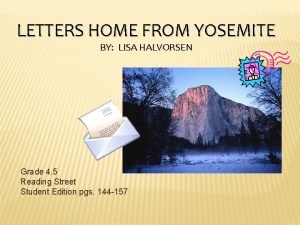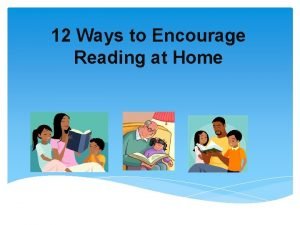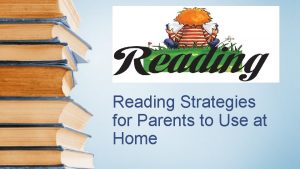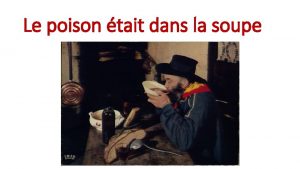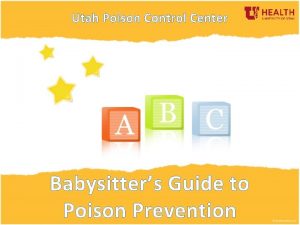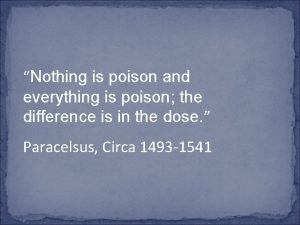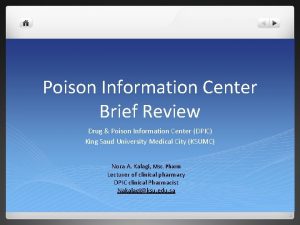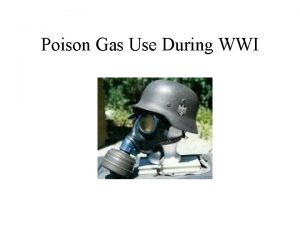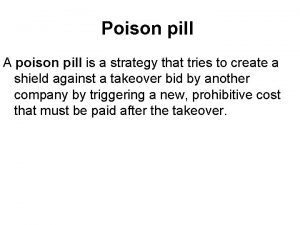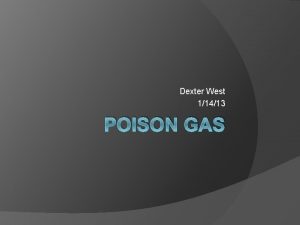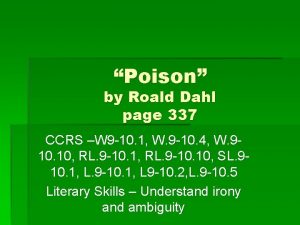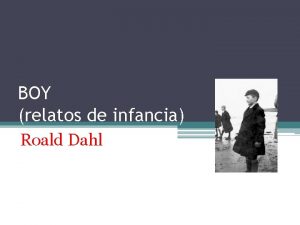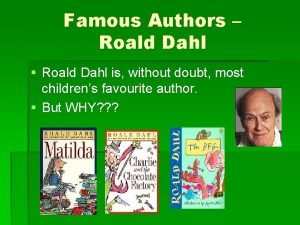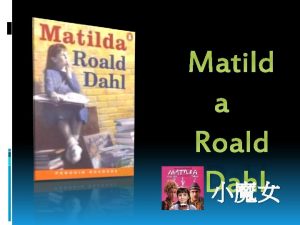HOME READING Poison 1 R Dahl is writer















- Slides: 15

HOME READING “Poison” 1. R. Dahl is. . . writer. a) an American b) a British c) an Australian 2. He took part in World War II as … a) a doctor b) a pilot c) a journalist 3. R. Dahl is the master of … a) detective stories b) humorous stories c) short stories with an unexpected twist

Match the words to their definitions a. to remove liquid from smth using a cloth or hands; 1. steady (adj) b. to take the position on the knees; 2. anaesthetic (n)c. a liquid that is put into blood to help to fight an infection or a poison; 3. sweat (v) d. the ability to control thoughts and behavior; e. a piece of flesh that is used for moving a particular part 4. swear (v) of the body; 5. chloroform (n)f. the soft part of the body between the chest and legs; 6. muscle (n) g. firmly held in a particular position without moving or shaking; 7. kneel (v) h. to make a sincere statement that you are telling the truth; 8. serum (n) i. to produce liquid on the surface of the skin when you are hot, nervous or ill; 9. wipe (v) j. a liquid with a strong smell that makes you become 10. willpower (n) unconscious; 11. stomach (n) k. a drug or gas that is given to make someone unconscious;

Check your answers • 1 g • 2 k • 3 i • 4 h • 5 j • 6 e • 7 b • 8 c • 9 a • 10 d • 11 f

Put these sentences in the order in which they happen A B C D The doctor arrives. Harry jumps up. Ganderbrai uses chloroform. Timber Woods goes to Ganderbrai’s house. E Harry sees the krait. F Harry is given some serum. G Harry becomes violently angry.

Check your answers • EDAFCBG

Reading Circles “ W S 1 C “ _______ W S 2 C ________

Discussion Leader story_________ name_________ The Discussion Leader’s job is to… “ • Read the story and prepare at least five general questions about it. • Ask 1 -2 questions to start the Reading Circle discussion. • Make sure that everyone has a chance to speak and joins in the discussion. • Call on each member to present their prepared role information. • Guide the discussion and keep it going. Usually the best discussion questions come from your own thoughts, feelings and questions as you read. (What surprised you, made you smile, made you feel sad? ) Other general ideas: • Question about the characters (true/not true to life), theme (friendship, romance, parents/children, the ending (surprising, expected) what will happen next.

Word Master story_________ name_________ The Word Master’s job is to… W • Read the story and look for words and short phrases that are new or difficult to understand, or are important in the story. • Choose 5 words (only five) that you think are important for the story. • Explain the meaning of these five words in simple English to the group. • Tell the group why these words are important for understanding this story. Your five words do not have to be new or unknown words. Look for words in the story that really stand out in some way. These may be words that are: - Repeated often – used in an unusual way – important to the meaning of the story My words _______ Page_____ Line_____ Meaning _______________ Reason for choosing _____________________________

Passage Person story_________ name_________ The Passage Person’s job is to… _________ • Read the story and find important, interesting, or difficult passages. • Make notes about at least three passages that are important for the plot, or that explain the characters, or that have very interesting or powerful language. • Read each passage to the group, or ask another group member to read it. • Ask the group one or two questions about each passage. A passage is usually one paragraph. But sometimes it can be just 1 -2 sentences, or a piece of a dialogue. You might choose a passage to discuss it because it is: -important – informative – surprising – funny – confusing- well-written My passages: Page_______ Lines______ Reasons for choosing _________ Questions about the passage ____________

Summarizer story_________ name_________ S The Summarizer job is to… • Read the story and make notes about the characters, events, ideas. • Find the key points that everyone must know to understand remember the story. • Retell the story in a short summary (1 -2 minutes) in your own words. • Talk about your summary to the group, using your writing to help you. Your reading circle will find your summary very useful, because it will help to remind them of the plot and the characters in the story. My key points: Main events: ________________________ Characters: _________________________ My summary: ________________

Connector story_________name_________ The Connector’s job is to… C • Read the story and look for connections between the story and the world outside. • Make notes about at least 2 possible connections to your own experiences of friends and family, or to real life events. • Tell the group about the connections and ask for their comments or questions. • Ask the group if they can think of any connections themselves. Events: Has anything similar happened to you, or someone you know? Does anything in the story remind you of events in the real world, events you have read about in newspapers, or heard about on television news programmes. Characters: Do any of them remind you of people you know? How? Why? Have you ever had the same thoughts or feelings as these characters have? Do you know anybody who thinks, feels, behaves like that?

Culture Collector story_________ name_________ The Culture Collector’s job is to… • Read the story and look for both differences and similarities between your own culture and the culture found in the story. • Make notes about two or three passages that show these cultural points. • Read each passage to the group, or ask another group member to read it. • Ask the group some questions about these and any other cultural points in the story. Here are some questions to help you think about cultural differences. Theme: What is theme of the story? Is it important theme in your own culture? Do people think about this theme in the same way or differently? People: Do characters in this story say or do things that people never say or do in your culture? Do they say or do some things that every body in the world says or does? My cultural collection (differences and similarities): 1. 2. page ______ lines_____________________ My cultural questions: _____________________

Answer these questions • • • Where does the story take place? What worried Timber when he got home? What did Timber plan to do if Harry was bitten? Is the doctor confident that the serum will protect Harry? Why was it so important to comfort Harry? What will the chloroform do to Harry? How much time did the doctor spend in the patient’s house? Why did Harry start jumping in the air? How did Harry thank the doctor? What do you think are the relationships of Harry, Timber and the doctor?

Answer the questions • 1. Do you think there really was a snake? • 2. What do you think is in each of the character’s minds at the end of the story?

Write a more final ending • Write 200 – 250 words
 Pre reading while reading and post reading activities
Pre reading while reading and post reading activities She said that, home economics stands for the ideal home.
She said that, home economics stands for the ideal home. Perbedaan home care dan home visit
Perbedaan home care dan home visit Oak springs rv park
Oak springs rv park Home sweet home: survive
Home sweet home: survive Mobile home parks for sale in sc
Mobile home parks for sale in sc Let's go to your house
Let's go to your house Unit 3 home sweet home
Unit 3 home sweet home Jr rabbin imam pretre
Jr rabbin imam pretre Arti home care
Arti home care Softly and tenderly jesus is calling
Softly and tenderly jesus is calling Letters home from yosemite reading street
Letters home from yosemite reading street Ways to encourage reading at home
Ways to encourage reading at home While my father was reading a newspaper
While my father was reading a newspaper Reading strategies for parents
Reading strategies for parents Adaptation in lotus plant
Adaptation in lotus plant











